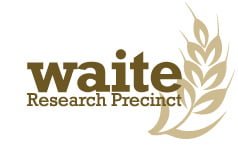
Above: Dr. Eleanor Dormontt and Dr. Stefan Caddy-Retalic accepting the award from the Deputy Premier. Photo supplied by Dr. Stefan Caddy-Retalic.
Future Trees Climate and Biosecurity Vulnerability Benchmarking Study
The Waite Arboretum team, led by Dr. Kate Delaporte and Dr. Stefan Caddy-Retalic, Dr. Eleanor Dormontt and Dr. James Dorey, undertook a benchmarking study into the current status of Adelaide’s urban forest. Their work was recognised last week for their action taken to address climate change in South Australia.
From the Government of South Australia’s Announcement:
 The Future Trees Climate and Biosecurity Vulnerability Benchmarking Study is the first step in a long-term work program to build the resilience of our urban forest against climate and biosecurity threats. The Waite Arboretum has combined data from 20 councils to map the demographics of more than 600,000 trees across Greater Adelaide. The project then identified how these trees are vulnerable to ongoing climate and biosecurity threats.
The Future Trees Climate and Biosecurity Vulnerability Benchmarking Study is the first step in a long-term work program to build the resilience of our urban forest against climate and biosecurity threats. The Waite Arboretum has combined data from 20 councils to map the demographics of more than 600,000 trees across Greater Adelaide. The project then identified how these trees are vulnerable to ongoing climate and biosecurity threats.
The benchmarking study identified 13 species that comprise more than half of all trees across Greater Adelaide. Some of the most abundant species are from subtropical or temperate climates and are unlikely to survive the ongoing warming and drying trends expected by 2050. This indicates that Adelaide must modify our planting choices to ensure that the city’s trees continue to flourish and provide important environmental and social benefits for the long term.
The work of the Waite Arboretum has identified opportunities for Adelaide to both increase the resilience of our green spaces and capitalise on resources and strengths to meet the need for climate-ready tree stock and advanced tree management skills nationally.
The project engaged with 20 local governments and multiple state government agencies,each with a major role in decisions on tree planting and management, to complete a trans-jurisdictional analysis of the tree canopy and its vulnerabilities.
The work of the Waite Arboretum has been recognised by both local and state government, including forming the basis for one of six priority areas in the state government’s draft Urban Greening Strategy.
